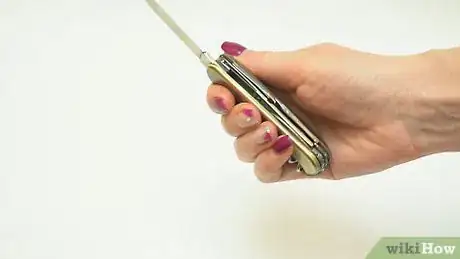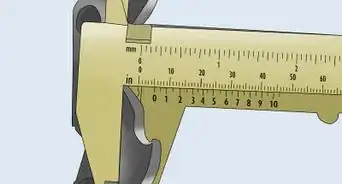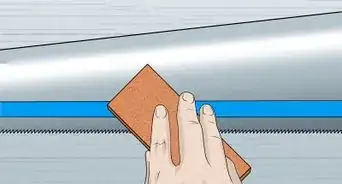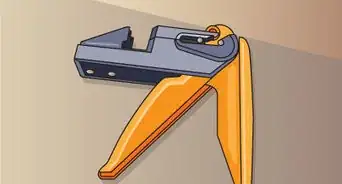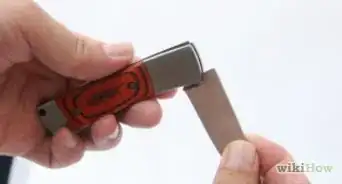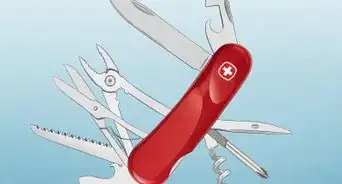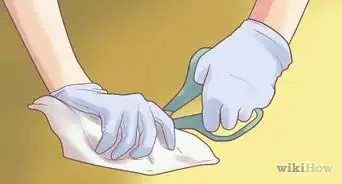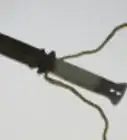This article was co-authored by wikiHow staff writer, Hunter Rising. Hunter Rising is a wikiHow Staff Writer based in Los Angeles. He has more than three years of experience writing for and working with wikiHow. Hunter holds a BFA in Entertainment Design from the University of Wisconsin - Stout and a Minor in English Writing.
There are 12 references cited in this article, which can be found at the bottom of the page.
The wikiHow Video Team also followed the article's instructions and verified that they work.
This article has been viewed 202,115 times.
Learn more...
Pocket knives are useful tools for making cuts on the go. Knives come in a variety of styles with different locking mechanisms to keep the blades secure. No matter what style knife you're using, it can easily be closed and stored safely back where it belongs in your pocket.
Steps
Closing Knives without a Lock
-
1Hold the knife by the sides of the hilt. Make sure your fingers aren't over the slot where the blade of the knife will go. Use a firm grip with the base of your palm and your thumb on one side and the pads of your fingers on the other.[1]
- Always point the blade away from your body. That way if your hand slips, the blade will fall away from you.
-
2Grip the back of the blade with your dominant hand. Hold the dull side of the blade between your thumb and your fingers. Many knives have a ridge along the top of the blade to give yourself a better grip.[2]
- Keep your fingers firmly help on the blade so you don't slip and cut yourself.
Advertisement -
3Push the knife into the slot slowly. Make sure the sharp edge of the blade is secured in the slot completely. Once the knife is closed, the blade should not open on its own.[3]
- Work with 2 hands until you're comfortable opening and closing your knife. After you feel confident handling the knife, you can practice closing your knife with 1 hand.
- Push the back of the blade against a solid surface to close it without using your fingers.
Shutting Knives with Liner and Frame Locks
-
1Find the part of liner or frame behind the blade on the underside of the hilt. Liner and frame locks move a portion of the outer or inner lining behind the blade to secure the knife in place. Look for a small saw-toothed portion directly behind the blade.[4]
- Liner locks use a portion of the interior lining to keep the blade in place while frame locks use a portion of the knife's outer casing.[5]
-
2Push the liner or frame away from the blade with your thumb. Hold the blade so the sharp side faces up. Move the locking mechanism so it isn't in contact with the blade. The knife will feel like it has less tension once you release the lock.[6]
- Holding the knife upside down prevents the blade from falling onto your thumb when you move the locking mechanism.
-
3Move your thumb before you close the knife with your dominant hand. Hold the blade with your other hand as you move your thumb. Make sure the blade is fully in the slot.[7]
- Frame and liner locks do not hold the blade closed, so use caution when you're carrying or handling them.
Securing a Button Lock Knife
-
1Hold the knife on the top of the hilt with your dominant hand. Make sure the bottoms of your fingers aren't wrapped around the hilt or you could cut yourself while closing it. Button lock knives can easily be operated with 1 hand, though you may want to practice closing it with 2 hands first.[8]
-
2Depress the button on the hilt with your thumb. The button lock can be found on the hilt near the base of the blade. Depending on the brand and style of knife, the button may appear different, but it usually looks like a small cylinder coming out of the surface of the knife. Press down on the button to undo the lock.[9]
- If you have trouble pressing the button, look at the inside of the locking mechanism to see if there's any buildup. Blow it away with your breath or use a small wire to clear the debris from the inside.
-
3Use your non-dominant hand to push the blade closed. Once the button is pressed, the blade will feel loose and can easily be moved back into place. Make sure your fingers are away from the slot as you secure the blade. Most button locks will hold the blade tight unless it is pressed again.[10]
- Check the manual for your blade to determine if the lock holds the knife in its casing.
Closing an Axis Lock Knife
-
1Pull the pin on the side of the hilt towards you with your thumb. The pin on the side of the knife will be connected to a U-shaped tension wire known as an omega spring. Hold the knife so it is parallel with the ground and pull the pin back to unlock the blade from its place.[11]
-
2Push the blade back with your other hand. Keep the pin pulled back as you move the blade to the closed position. Make sure your fingers aren't on the bottom of the hilt or else you will get cut.[12]
- Keep your fingers on the dull side of the blade while working with the knife.
-
3Release the pin to secure the blade. Once the blade is in the hilt, let go of the pin to put tension back on the knife. The axis lock holds the blade safely open or closed unless it is pulled back again.[13]
- You can pull the knife open by the blade, but the tension from the omega springs will make it more difficult.
Community Q&A
-
QuestionBar lock is too hard to depress on my Barlow pocket knife, making if impossible to close the blade by hand only. Any ideas?
 Tom De BackerTop AnswererSee if you can find any visible blockages of the bar lock. If possible, try taking the knife apart to clean and maintain it, and perhaps that will show the blockage. Perhaps the knife just needs some oiling. If that's the case, again, make very sure no fingers are in the way, because it will close much smoother than you may be used to, putting your fingers at risk. Finally, if none of these work, take it to a knife shop.
Tom De BackerTop AnswererSee if you can find any visible blockages of the bar lock. If possible, try taking the knife apart to clean and maintain it, and perhaps that will show the blockage. Perhaps the knife just needs some oiling. If that's the case, again, make very sure no fingers are in the way, because it will close much smoother than you may be used to, putting your fingers at risk. Finally, if none of these work, take it to a knife shop. -
QuestionHow do you close a pocket knife without a lock?
 Drew Hawkins1Community AnswerIt's actually much easier than you may think to close a knife without a lock. Start by holding the knife safely. Make sure your fingers aren't over the slot where the blade of the knife will go. Use a firm grip with the base of your palm and your thumb on one side and the pads of your fingers on the other. Then, hold the dull side of the blade with your thumb and fingers and slowly push the knife into the slot and make sure the sharp edge of the blade is secured in the slot completely. If you don't want to use your fingers, you can push the back of the blade against a solid surface to close it. That's it!
Drew Hawkins1Community AnswerIt's actually much easier than you may think to close a knife without a lock. Start by holding the knife safely. Make sure your fingers aren't over the slot where the blade of the knife will go. Use a firm grip with the base of your palm and your thumb on one side and the pads of your fingers on the other. Then, hold the dull side of the blade with your thumb and fingers and slowly push the knife into the slot and make sure the sharp edge of the blade is secured in the slot completely. If you don't want to use your fingers, you can push the back of the blade against a solid surface to close it. That's it! -
QuestionHow can I close a pocket knife with a button lock?
 Drew Hawkins1Community AnswerSome pocket knives use a button lock mechanism that keeps the blade open and locked into place, but they're actually pretty simple to close. Grip the knife on the top part of the hilt with your dominant hand. Make sure the bottoms of your fingers aren't wrapped around the hilt or you could cut yourself while closing it. Then, press down on the button and hold it down. If the button is difficult to push down, check inside the locking mechanism to see if there's a gunky buildup. If there is, try to blow it clear with your breath or use a small wire to clear it out. With the button held down, use your other hand to push the blade closed. Many button lock knives will hold the blade tight in place until it's pressed again, but make sure the blade isn't loose or will swing open on its own. Whenever you want to open the knife back up, simply press the button and pull the blade open.
Drew Hawkins1Community AnswerSome pocket knives use a button lock mechanism that keeps the blade open and locked into place, but they're actually pretty simple to close. Grip the knife on the top part of the hilt with your dominant hand. Make sure the bottoms of your fingers aren't wrapped around the hilt or you could cut yourself while closing it. Then, press down on the button and hold it down. If the button is difficult to push down, check inside the locking mechanism to see if there's a gunky buildup. If there is, try to blow it clear with your breath or use a small wire to clear it out. With the button held down, use your other hand to push the blade closed. Many button lock knives will hold the blade tight in place until it's pressed again, but make sure the blade isn't loose or will swing open on its own. Whenever you want to open the knife back up, simply press the button and pull the blade open.
Warnings
- Watch your fingers so they aren't in the blade's path when you close the knife.⧼thumbs_response⧽
- Hold knives so the blades are pointed away from your body.⧼thumbs_response⧽
References
- ↑ https://youtu.be/N-8MHfs1qOc?t=54s
- ↑ https://youtu.be/N-8MHfs1qOc?t=51s
- ↑ https://youtu.be/NnFkejwMHHY?t=28s
- ↑ https://youtu.be/N-8MHfs1qOc?t=40s
- ↑ http://knifeinformer.com/pocket-knife-lock-types/
- ↑ https://youtu.be/NnFkejwMHHY?t=1m28s
- ↑ https://youtu.be/N-8MHfs1qOc?t=56s
- ↑ https://youtu.be/G0gvaJkQYEo?t=1m25s
- ↑ https://youtu.be/G0gvaJkQYEo?t=7m27s
